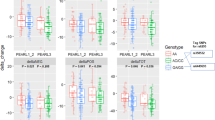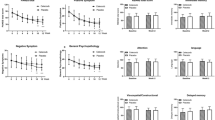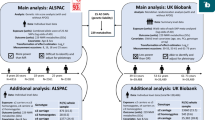Abstract
Accumulating evidence implicates deficiencies in apolipoprotein D (ApoD) function and arachidonic acid signaling in schizophrenic disorders. We addressed two hypotheses in relation to ApoD: first, polymorphisms in the ApoD gene confer susceptibility to or are markers of disease, and, second, genetic variation in the ApoD is associated with long-term clinical outcome to antipsychotic treatment. We genotyped two single-nucleotide polymorphisms in the ApoD gene in 343 chronic patients with schizophrenia spectrum disorders (ICD-10) and 346 control subjects of Danish origin. We did not find ApoD alleles, genotypes or haplotypes to be associated with disease. However, we did find that long-term clinical outcome was associated with the ApoD polymorphism rs7659 (P=0.041) following adjustment for lifetime clinical global impression, age at first admission and gender.
This is a preview of subscription content, access via your institution
Access options
Subscribe to this journal
Receive 6 print issues and online access
$259.00 per year
only $43.17 per issue
Buy this article
- Purchase on Springer Link
- Instant access to full article PDF
Prices may be subject to local taxes which are calculated during checkout
Similar content being viewed by others
References
Mahadik SP, Evans DR . Is schizophrenia a metabolic brain disorder? Membrane phospholipid dysregulation and its therapeutic implications. Psychiatr Clin N Am 2003; 26: 85–102.
Thomas EA, Copolov DL, Sutcliffe JG . From pharmacotherapy to pathophysiology: emerging mechanisms of apolipoprotein D in psychiatric disorders. Curr Mol Med 2003; 3: 408–418.
Skosnik PD, Yao JK . From membrane phospholipid defects to altered neurotransmission: is arachidonic acid a nexus in the pathophysiology of schizophrenia? Prostaglandins Leukot Essent Fatty Acids 2003; 69: 367–384.
Lundbaek JA, Andersen OS, Werge T, Nielsen C . Cholesterol-induced protein sorting: an analysis of energetic feasibility. Biophys J 2003; 84: 2080–2089.
Lundbaek JA, Birn P, Hansen AJ, Sogaard R, Nielsen C, Girshman J et al. Regulation of sodium channel function by bilayer elasticity: the importance of hydrophobic coupling. Effects of Micelle-forming amphiphiles and cholesterol. J Gen Physiol 2004; 123: 599–621.
Dilley WG, Haagensen DE, Cox CE, Wells Jr SA . Immunologic and steroid binding properties of the GCDFP-24 protein isolated from human breast gross cystic disease fluid. Breast Cancer Res Treat 1990; 16: 253–260.
Drayna D, Fielding C, McLean J, Baer B, Castro G, Chen E et al. Cloning and expression of human apolipoprotein D cDNA. J Biol Chem 1986; 261: 16535–16539.
Francone OL, Gurakar A, Fielding C . Distribution and functions of lecithin:cholesterol acyltransferase and cholesteryl ester transfer protein in plasma lipoproteins. Evidence for a functional unit containing these activities together with apolipoproteins A-I and D that catalyzes the esterification and transfer of cell-derived cholesterol. J Biol Chem 1989; 264: 7066–7072.
Simard J, Veilleux R, de Launoit Y, Haagensen DE, Labrie F . Stimulation of apolipoprotein D secretion by steroids coincides with inhibition of cell proliferation in human LNCaP prostate cancer cells. Cancer Res 1991; 51: 4336–4341.
Glenthoej B, Gerlach J, Licht R, Gulmann N, Joergensen O . Clearing rapport no.5 treatment with antispychotics. Recommended guidelines. Klarings rapport no. 5. Behandlings med Antopsykotika. Vejledende retningslinier. Danish Psychiatric Association, 1998.
Morais Cabral JH, Atkins GL, Sanchez LM, Lopez-Boado YS, Lopez-Otin C, Sawyer L . Arachidonic acid binds to apolipoprotein D: implications for the protein's function. FEBS Lett 1995; 366: 53–56.
Thomas EA, George RC, Sutcliffe JG . Apolipoprotein D modulates arachidonic acid signaling in cultured cells: implications for psychiatric disorders. Prostaglandins Leukot Essent Fatty Acids 2003; 69: 421–427.
Yao JK, Thomas EA, Reddy RD, Keshavan MS . Association of plasma apolipoproteins D with RBC membrane arachidonic acid levels in schizophrenia. Schizophr Res 2005; 72: 259–266.
Rassart E, Bedirian A, Do CS, Guinard O, Sirois J, Terrisse L et al. Apolipoprotein D. Biochim Biophys Acta 2000; 1482: 185–198.
Yang CY, Gu ZW, Blanco-Vaca F, Gaskell SJ, Yang M, Massey JB et al. Structure of human apolipoprotein D: locations of the intermolecular and intramolecular disulfide links. Biochemistry 1994; 33: 12451–12455.
Sanchez D, Ganfornina MD, Gutierrez G, Marin A . Exon–intron structure and evolution of the Lipocalin gene family. Mol Biol Evol 2003; 20: 775–783.
Terrisse L, Poirier J, Bertrand P, Merched A, Visvikis S, Siest G et al. Increased levels of apolipoprotein D in cerebrospinal fluid and hippocampus of Alzheimer's patients. J Neurochem 1998; 71: 1643–1650.
Navarro A, Del Valle E, Astudillo A, Gonzalez dR, Tolivia J . Immunohistochemical study of distribution of apolipoproteins E and D in human cerebral beta amyloid deposits. Exp Neurol 2003; 184: 697–704.
Mahadik SP, Khan MM, Evans DR, Parikh VV . Elevated plasma level of apolipoprotein D in schizophrenia and its treatment and outcome. Schizophr Res 2002; 58: 55–62.
Thomas EA, Dean B, Pavey G, Sutcliffe JG . Increased CNS levels of apolipoprotein D in schizophrenic and bipolar subjects: implications for the pathophysiology of psychiatric disorders. Proc Natl Acad Sci USA 2001; 98: 4066–4071.
Mancama D, Arranz MJ, Kerwin RW . Genetic predictors of therapeutic response to clozapine: current status of research. CNS Drugs 2002; 16: 317–324.
Masellis M, Basile VS, Ozdemir V, Meltzer HY, Macciardi FM, Kennedy JL . Pharmacogenetics of antipsychotic treatment: lessons learned from clozapine. Biol Psychiatry 2000; 47: 252–266.
Thomas EA, Danielson PE, Nelson PA, Pribyl TM, Hilbush BS, Hasel KW et al. Clozapine increases apolipoprotein D expression in rodent brain: towards a mechanism for neuroleptic pharmacotherapy. J Neurochem 2001; 76: 789–796.
Khan MM, Parikh VV, Mahadik SP . Antipsychotic drugs differentially modulate apolipoprotein D in rat brain. J Neurochem 2003; 86: 1089–1100.
Lewis CM, Levinson DF, Wise LH, DeLisi LE, Straub RE, Hovatta I et al. Genome scan meta-analysis of schizophrenia and bipolar disorder, part II: Schizophrenia. Am J Hum Genet 2003; 73: 34–48.
Desai PP, Hendrie HC, Evans RM, Murrell JR, DeKosky ST, Kamboh MI . Genetic variation in apolipoprotein D affects the risk of Alzheimer disease in African-Americans. Am J Med Genet 2003; 116B: 98–101.
McGuffin P, Farmer A, Harvey I . A polydiagnostic application of operational criteria in studies of psychotic illness. Development and reliability of the OPCRIT system. Arch Gen Psychiatry 1991; 48: 764–770.
Jakobsen KD, Frederiksen JN, Hansen T, Jansson LB, Parnas J, Werge T . Reliability of clinical ICD-10 schizophrenia diagnoses. Nordic J Psychiatry 2005; 59: 209–212.
Haro JM, Kamath SA, Ochoa S, Novick D, Rele K, Fargas A et al. The Clinical Global Impression-Schizophrenia scale: a simple instrument to measure the diversity of symptoms present in schizophrenia. Acta Psychiatr Scand Suppl 2003; 416: 16–23.
American Psychiatric Association. Treatment Guidelines. www.Psych Org/Psych_Pract/Treatg/ 2005.
Meltzer HY, Rabinowitz J, Lee MA, Cola PA, Ranjan R, Findling RL et al. Age at onset and gender of schizophrenic patients in relation to neuroleptic resistance. Am J Psychiatry 1997; 154: 475–482.
Liu HX, Chew SL, Cartegni L, Zhang MQ, Krainer AR . Exonic splicing enhancer motif recognized by human SC35 under splicing conditions. Mol Cell Biol 2000; 20: 1063–1071.
Tregouet DA, Escolano S, Tiret L, Mallet A, Golmard JL . A new algorithm for haplotype-based association analysis: the stochastic-EM algorithm. Ann Hum Genet 2004; 68 (Part 2): 165–177.
Wittke-Thompson JK, Pluzhnikov A, Cox NJ . Rational inferences about departures from Hardy–Weinberg equilibrium. Am J Hum Genet 2005; 76: 967–986.
Packer BR, Yeager M, Staats B, Welch R, Crenshaw A, Kiley M et al. SNP500Cancer: a public resource for sequence validation and assay development for genetic variation in candidate genes. Nucleic Acids Res 2004; 32: D528–D532.
Acknowledgements
We thank patients who participated in the Danish Psychiatric Biobank and made this study possible. We also acknowledge the help of numerous mental health professionals in the various clinical departments and research technicians. This study was financed through grant to TW from the Danish Research Agency under the Center for Pharmacogenomics and the Danish Psychiatric Research Foundation.
Author information
Authors and Affiliations
Corresponding author
Rights and permissions
About this article
Cite this article
Hansen, T., Hemmingsen, R., Wang, A. et al. Apolipoprotein D is associated with long-term outcome in patients with schizophrenia. Pharmacogenomics J 6, 120–125 (2006). https://doi.org/10.1038/sj.tpj.6500350
Received:
Revised:
Accepted:
Published:
Issue Date:
DOI: https://doi.org/10.1038/sj.tpj.6500350
Keywords
This article is cited by
-
Variations in apolipoprotein D and sigma non-opioid intracellular receptor 1 genes with relation to risk, severity and outcome of ischemic stroke
BMC Neurology (2014)
-
Meta-analysis of gene coexpression networks in the post-mortem prefrontal cortex of patients with schizophrenia and unaffected controls
BMC Neuroscience (2013)
-
Expression and potential role of apolipoprotein D on the death–survival balance of human colorectal cancer cells under oxidative stress conditions
International Journal of Colorectal Disease (2013)
-
Diagnostic stability among chronic patients with functional psychoses: an epidemiological and clinical study
BMC Psychiatry (2007)



